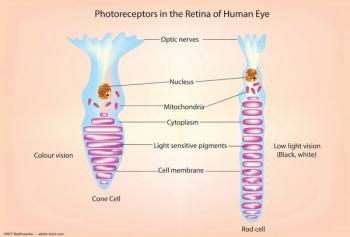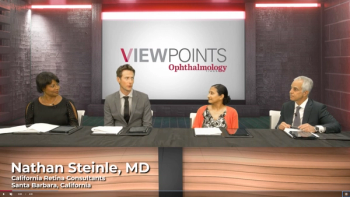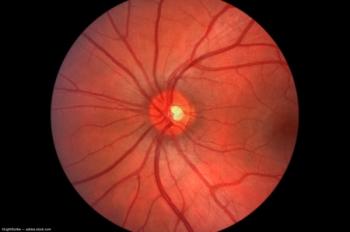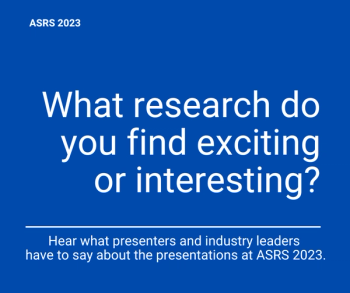
According to the Louisiana State University Health Sciences Center, elovanoids have been shown to restore the structure and integrity of damaged photoreceptor cells by repairing, remodeling and regenerating healthy cells.

According to the Louisiana State University Health Sciences Center, elovanoids have been shown to restore the structure and integrity of damaged photoreceptor cells by repairing, remodeling and regenerating healthy cells.

A panel of retina specialists weighed in on the dosing intervals when using of faricimab for the treatment of neovascular AMD in the clinical practice setting. Do you agree with them?

The competition is offering an opportunity for amateur and professional photographers to demonstrate their skills and share with the world what they see and what it means to #LoveYourEyes.

According to the company, the clinical study update suggests continued positive trends in best-corrected visual acuity and multi-luminance mobility testing as well as positive trends in low-luminance visual acuity among treated eyes.

A panel of esteemed retina specialists recently delved into innovative therapies for neovascular age-related macular degeneration and diabetic macular edema, focusing on personalized treatment, telemedicine, and the ongoing quest for advancements.

The Ophthalmic World Leaders (OWL) Leadership Summit, scheduled for September 21 and 22, 2023, in Austin, Texas, will feature a lineup of prominent speakers and engaging discussions on a wide range of leadership topics and industry insights.

Novartis acquired Gyroscope Holdings Limited from Syncona in February 2022.

Alex Gorsky currently sits on the boards of Apple, IBM, JPMorgan Chase, and the Travis Manion Foundation, as well as the Wharton School of the University of Pennsylvania Board of Advisors.

The podcast by Cognition Therapeutics features a discussion with retinal specialists.

In this key role, Weil will lead the organization to commercial readiness from designing launch strategies for the US and globally.

Walgreens Boots Allianc Inc. and CVS Health are among the companies the FDA sent letters to for violating federal law.

The company is expanding its patent portfolio to 10 granted patents and 32 pending patent applications.

According to the company, OPGx-LCA5 is designed to address vision loss due to Leber congenital amaurosis associated with mutations in the LCA5 gene, which causes one of the most severe early-onset retinal dystrophies.

The non-profit will partner with the imaging company to prevent blindness and fund new retinoblastoma research.

According to the companies, the collaboration has the potential to benefit patients who have suffered from specific, chronic ocular diseases.

A new survey shows that 95% of adults at risk for certain retinal diseases know a little or nothing about them. Allen hopes her story will help raise awareness and encourage those at risk to regularly prioritize their eye health.

According to the company, 4D-150 comprises its customized and evolved intravitreal vector, R100, and a transgene cassette that expresses both aflibercept and a VEGF-C inhibitory RNAi.

Ocular Therapeutic, Rezolute, and Opthea will all present at the H.C. Wainwright 25th Annual Global Investment Conference being held in New York City in September.

According to the company, it has 9 presentations at the annual congress of the European Society of Cataract and Refractive Surgeons being held in Vienna. AVG also is a sponsor of the International Society of Presbyopia.

The beauty brand announces Ashley Brissette, MD, MSc, FRCSC, will be the brand's first guiding ophthalmologist.

DMEI is 1 of only 17 centers in the US certified to provide this specialized treatment. Previously, patients in the region who qualified for LUXTURNA would have had to travel to other states to receive treatment.

According to the company, NFS-05, utilizes a gene therapy approach that delivers an AAV vector containing the OPA1 gene into the vitreous cavity.

According to the company, the deal expands its European footprint into Spain and Portugal.

This office supports Akari’s current expansion of operations as the company prepares to start of enrollment in 2 registrational nomacopan Phase 3 clinical trials in pediatric and adult HSCT-TMA and the start of PAS-nomacopan clinical trials in GA.

The 6-month-old boy’s dark brown eyes turned deep blue after he was treated for COVID with favipiravir.

EyeSouth Partners has partnered with Retina and Vitreous of Texas, a retina-only practice in Houston, Texas. The company’s current network encompasses 38 practices and over 300 doctors who deliver medical and surgical eye care services across more than 180 locations.

According to the company, the tool provides free access to training and mentors for eye care professionals in areas with the greatest need, and the new Cybersight mobile app expands access for eye care professionals through offline functionality.

The experimental gene therapy was administered as a treatment in part of a randomized, partially masked, controlled, phase 3 clinical study evaluating the efficacy and safety of an experimental therapy, ABBV-RGX-314, for wet AMD.

We asked, "What research at ASRS 2023 do you find exciting or interesting?" Here's what Paul Hahn, MD, Kerrie Brady, BPharm, MBA, MS, and Michael Singer, MD had to say!

Our team spoke with several researchers and industry professionals at the 2023 American Society of Retina Specialists meeting in Seattle, Washington. We asked them, "What research here do you find exciting or interesting?" Here's what Tarek Hassan, MD, Nancy Lurker, and J. Fernando Arevalo, MD, PhD, FACS, FASRS, had to say!